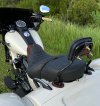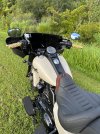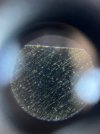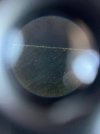Non.Nisi.Te
Gold Member
- Joined
- Apr 2, 2020
- Messages
- 776
The BladeForums.com 2024 Traditional Knife is available! Price is $250 ea (shipped within CONUS).
Order here: https://www.bladeforums.com/help/2024-traditional/
Nice seat !
You could replace the tank cover too - in older Harleys they were made of leather and had a little pouch that I use for wheel lock or cigarettes.




Is that a Heavy Chopper? It looks bulkier than an MC
Hello, Is a MCIs that a Heavy Chopper? It looks bulkier than an MC




Perfect for the lucky kid! Sweet ride!Thanks!
Probably worth mentioning this is a different "bike" than the last one. My daughter (11yo) has been riding with me a ton, she loves going to various get-togethers and group rides. After our umpteenth time nearly getting taken out by someone driving like they were in a video game my wife and I decided to get something bigger with more road presence rather than give it up all together. It works, this thing is almost as big as a Cooper and not having feet to worry about allows me to focus more on surroundings, of course rule #1 was I had to make it loud
I miss my Softail and the twin cam, but we ride a lot more now and as a lifelong ATV rider I'm right at home on it, plus I won't need to shop for one later in life
Aside from the seat all of the leather is custom, the sissy bar pad is my first attempt at "upholstery".
View attachment 2971831
View attachment 2971832
View attachment 2971833
View attachment 2971834
Nice write up explaining the process!!
Once, I saw a discussion about sharpening angles for knives.The context was that 20 degrees was supposedly "too much," and a knife "doesn't cut" at such angles.Well, I have an SDFK in my hands, which has become an upgraded version of itself—now it’s an SSSDFK (Super Sharp Super Duty Field Knife). I also considered calling it SSSSSDFK, like Super Shiny Super Sharp Super Duty Field Knife, but that feels a bit too long, so pick whichever name you like.
!TO THE POINT!
resharpened the factory angle of 22 DPS to 22.5 DPS (just because I felt like it, don’t ask why).I love sharpening knives, examining carbides under a microscope, making interesting observations, and stuff like that.My goal is to show that, in essence, even 22 degrees can be an EXTREMELY AGGRESSIVE sharpness in terms of cutting performance.
I started sharpening with a 50/40 (280 grit) abrasive, as I don’t need a coarser stone—I just work a bit longer with a gentler abrasive.
View attachment 2974132
Then I shape and perfect the edge, even at micron-level precision, and remove the burr on each stone, as this makes it easier to control the formation of the burr with subsequent stones. This is necessary, at least if I want to maximize the results I achieve.
Essentially, from my perspective, I achieve the ideal edge and primary sharpness with a 20/14 abrasive (around 600-700 grit). Grit values aren’t always reliable for understanding micron sizes on abrasives. In reality, we might not have much grit on an abrasive with fewer microns, which results in a significantly more aggressive cut.
This is what I get with 600-700 grit.
View attachment 2974133
You might notice that I sharpen at my own specific angle and direct the abrasive scratches in one particular direction. Ask me why? I’ll answer: it’s just better, plain and simple. I’ve spent a lot of time figuring out which direction generally works best for knives.
(This is MY experience and opinion. I know many will talk about more "efficient" methods, but I only trust my own experience.)
Here’s a 7/5 stone (that’s 2000 grit).
The jump is quite significant, and there should be an intermediate stone between them, but this way, I keep the carbides exposed. At 300x magnification under a microscope, you can see it. The microscope isn’t top-tier, but if you look closely, they’re there. (Trust me, they really are!)
View attachment 2974134
Here’s the trick: the surface is already perfectly polished (at this point, I get a cutting edge that starts to become mirror-like).
Yet, the carbides remain on the cutting edge, making it more aggressive.
For the final stage, I slightly increase the angle on the sharpener, raising it by just 0.05 degrees. This way, with a very soft abrasive, I ensure a consistent reach to the cutting edge, but I work longer to achieve a highly uniform surface.
Here, the grit is 3/2 (4000 grit), which seems remarkable, especially since it’s CBN, essentially like diamond. Yet, I achieve a perfectly aggressive and perfectly mirror-like cutting edge, without any stray scratches.
View attachment 2974145
Now for the most interesting part: how a 22.5 DPS edge cuts on the fairly thick SSSDFK (Super Sharp Super Duty Field Knife), or you could call it the Super Shiny Super Sharp Super Duty Field Knife (whichever you prefer).
As I see it, all the theory and microscopy aren’t as interesting without proof, so here it is!
P.S
I did this because it’s just fun.
And to show that, in reality, the DPS value on a knife isn’t that critical, especially considering you can maximize the result through sharpening.
It’s fun and simple (isn’t it?).
Plus, it’s pretty cool to see the sharpening process under a microscope and observe the maximum potential of the steel—not just in terms of strength but also sharpness, without going to extremely low DPS angles. In my opinion, this level of sharpness, aggression, and edge retention is MORE than you could potentially need.
"KNIFE SHINES AND CUTS (CLICKBAIT!)"
I definitely need to brush up on my English, and also on how I make videos, so that the results are even more visually apparent.Nice write up explaining the process!!
